Research in Jon’s group is focused advancing the frontiers of synthetic organic chemistry, training the next generation of excellent molecular architects, and applying those skills and interests towards practical applications in arenas such as materials (polymers), drug discovery, total synthesis etc. where design of creative and practical routes of is critical for success. Detailed Graphical Research Summary Below.

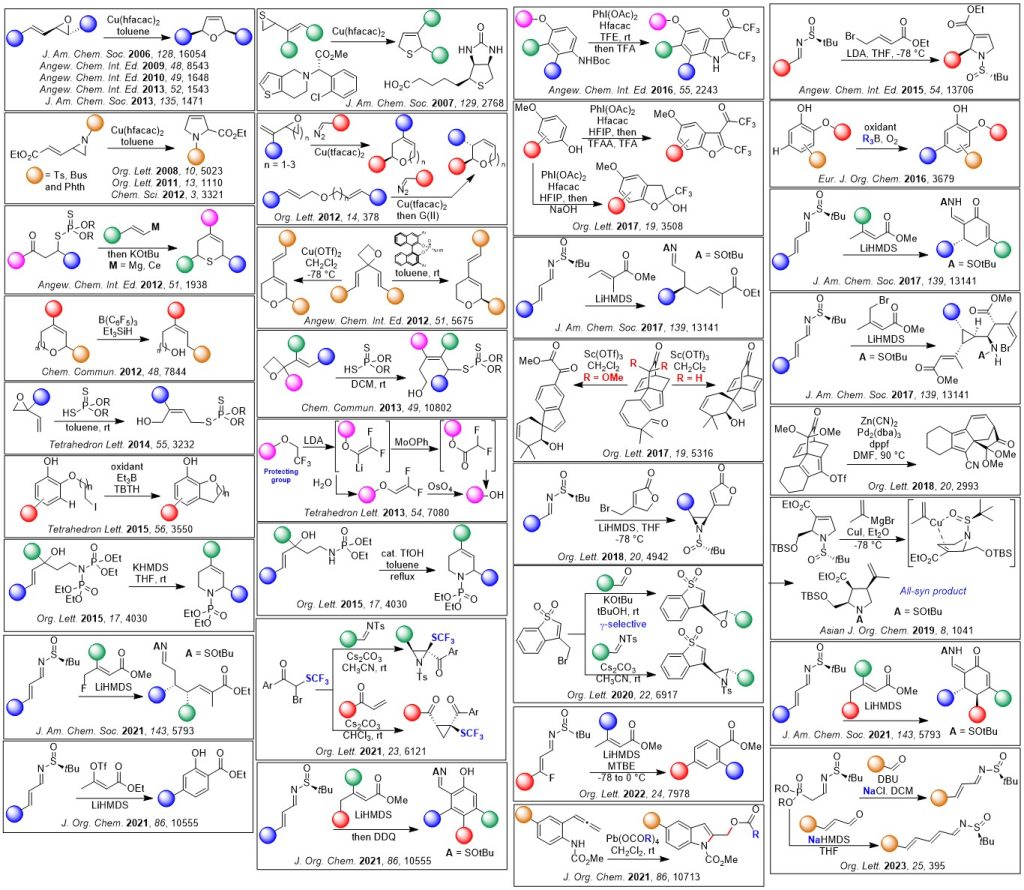

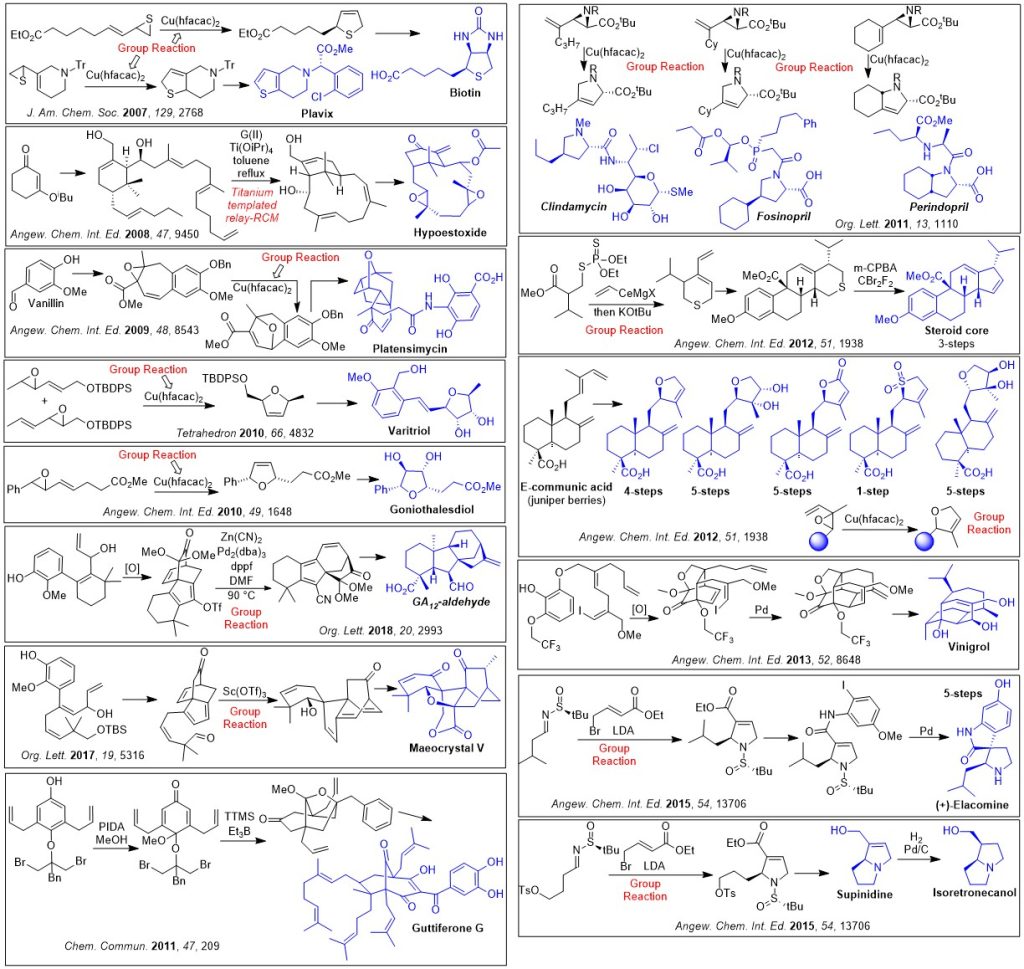

The Njardarson group has since 2019 been collaboration with Professor Jeff Pyun’s group (Department of Chemistry and Biochemistry, UArizona), the inventor of inverse vulcanization, on making novel classes of designer organic monomers for engaging abundant sulfur sources such as elemental sulfur (S8), sulfur monochloride (S2Cl2) and others to make sulfur-rich materials for diverse optical applications, which in collaboration with Professor Robert Norwood’s group, (College of Optics, UArizona). Listed below are publications from this exciting collaborations.
(1) Lee, T.; Dirlam, P. T.; Njardarson, J. T.; Glass, R. S.; Pyun, J. “Polymerizations with Elemental Sulfur: From Petroleum Refining to Polymeric Materials” J. Am. Chem. Soc. 2022, 144, 5.
(2) Kang, K.-S.; Olikagu, C.; Lee, T.; Bao, J.; Molineux, J.; Holmen, L. N.; Martin, K. P.; Kim, K.-J.; Kim, K.-H.; Bang, J.; Kumirov, V. K.; Glass, R. S.; Norwood, R. B.; Njardarson, J. T.; Pyun, J. “Sulfenyl Chlorides: An Alternative Monomer Feedstock from Elemental Sulfur for Polymer Synthesis” J. Am. Chem. Soc. 2022, 144, 23044.
(3) Pyun, D. C.; Norwood, R.; Njardarson, J. T.; Glass, R.; Lee, T.; Olikagu, C.; Kang, K.-S. “Flame Retardant Polymers and Processes for Producing and Using the Same” WO2023043735 issued March 23rd 2023.
(4) Pyun, D. C.; Norwood, R.; Njardarson, J. T.; Kang, K.-S.; Glass, R.; Lee, T.; Olikagu, C.; Carothers, K. “Polymers Obtained from Unsaturated Compounds and Sulfur Halides” WO2023043737 issued March 23rd 2023.
(5) Bao, J.; Martin, K. P.; Cho, E.; Kang, K.-S.; Glass, R. S.; Coropceanu, V.; Bredas, J.-L.; Parker, W. O’Neil.; Njardarson, J. T.; Pyun, J. “On the Mechanism of the Inverse Vulcanization of Elemental Sulfur: Structural Characterization of Poly(sulfur-random-(1,3-diisopropenylbenzene))” J. Am. Chem. Soc. 2023, 145, 12386.
(6) Qureshi, M. H.; Bao, J.; Kleine, T. S.; Kim, K.-J.; Carothers, K. J.; Molineux, J.; Cho, E.; Lee, T.; Kang, K.-S.; Godman, N.; Coropceanu, V.; Bredas, J.-L.; Norwood, R. B.; Njardarson, J. T.; Pyun, J. “Synthesis of Deuterated & Sulfurated Polylmers by Inverse Vulcanization: Engineering Infrared Transparency via Deuteration” J. Am. Chem. Soc. 2023, 145, 27821.
(7) Olikagu, C.; Kumirov, V. K.; Njardarson, J. T.; Hahn, M. J.; Pyun, J. P. “NMR Spectroscopic Characterization of Polyhalodisulfides via Sulfenyl Chloride Inverse Vulcanization with Sulfur Monochloride” Polymer 2024, 290, 126539.
(8) Bao, J.; Kang, K.-S.; Molineux, J.; Bischoff, D. J.; Mackay, M. E.; Pyun, J.; Njardarson, J. T. “Dithiophosphoric Acids for Polymer Functionalizations” Angew. Chem. Int. Ed. 2024, 63, e202315963.
In 2023 the Njardarson group started a new collaboration with Professor Zafer Mutlu (Department of Material Science and Engineering, UArizona) towards designer syntheses of precisely assembled nanomaterial structures for quantum computing and other applications.

Njardarson group is focused on making advances in addressing neurodegenerative disease conditions and has long standing active programs in (ALS), in collaboration with Professor Daniela Zarnescu (Penn State University), and Parkinson’s in collaboration with a team of University of Arizona research groups. All structures driving these programs are synthesized from scratch in the Njardarson either using Njardarson group new reactions or derived/inspired from natural products. This work is funded to DoD, Critical Path Institute and supported by patents. Publications coming soon.

As part of the collaborative sulfur-polymerization efforts with Professor Jeffrey Pyun and Professor Robert Norwood, we are also collaborating with Professor Dennis Lichtenberger and Professor Jean-Luc Bredas (both UArizona), as part of an NSF DMREF grant mechanism, using machine learning to aid in accelerating the development of new sulfur-rich materials for optical applications.
Most recent machine learning collaboration is focus on converting the content of our Chemistry By Design application/website into machine readable format. Exciting news coming soon!

The Njardarson group has since its founding focused extensively on developing new organic-chemistry centric educational material to help the students/researchers of tomorrow learn and navigate information content faster. These products have enjoyed widespread success to date and are listed below along with publications.
Top 200 Pharmaceutical Posters (2006-Present): The Njardarson group created these free posters to celebrate the amazing structural diversity and impact of drug structures made by organic chemists in the pharmaceutical industry. Three Top 200 Poster themes have been created as organizational principles focused on (1) Retail Sales, (2) Number of Prescriptions and (3) Small Molecules only Retails Sales. This effort has been detailed in the following publication: McGrath, N. A.; Brichacek, M.; Njardarson J. T. “A Graphical Journey of Innovative Organic Architectures That Have Improved Our Lives”, J. Chem. Ed. 2010, 87, 1348-1349.
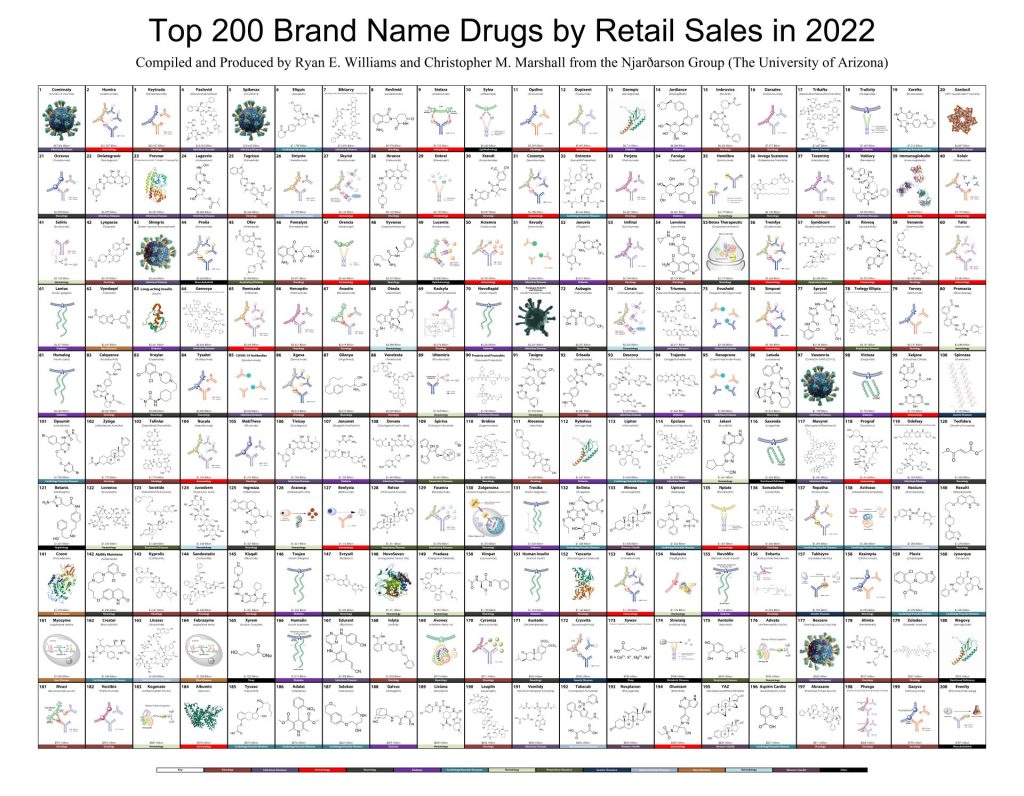
Chemistry By Design (2011-Present): Professor Njardarson created the application (app) and website Chemistry By Design in 2011. This free educational product is updated with new content weekly and enables users to learn about the amazing organic chemistry and creative synthetic designs in the area of natural product total syntheses and syntheses of pharmaceuticals. This app comes with a flashcard feature allowing the user to test their skills in predicting starting materials, products or reagents for any given reaction. The origin story and design principles for this project are detailed in the following publication: Draghici, C.; Njardarson, J. T. “Chemistry By Design – A Web Based Educational Flashcard for Exploring Synthetic Organic Chemistry”, J. Chem. Ed. 2012, 89, 1080-1082.
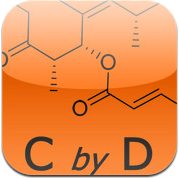
Disease and Structure Focused Posters (2013-Present): Following the success of the Njardarson group Top 200 Pharmaceutical posters the group set out to draw all of the structures of US FDA approved small molecule drugs and present them in new series of posters focused on new organizational principles namely 1) Diseases (12 posters) and 2) structures (3 posters – Sulfur – Fluorine and Chlorine). These posters can be downloaded from Free from this website and these efforts have been documented in the following publication: Ilardi, E. A.; Vitaku, E.; Njardarson, J. T. “An In-Pharm-ative Educational Poster Anthology Highlighting the Therapeutic Agents that Chronicle Our Medicinal History”, J. Chem. Ed. 2013, 90, 1403-1405.
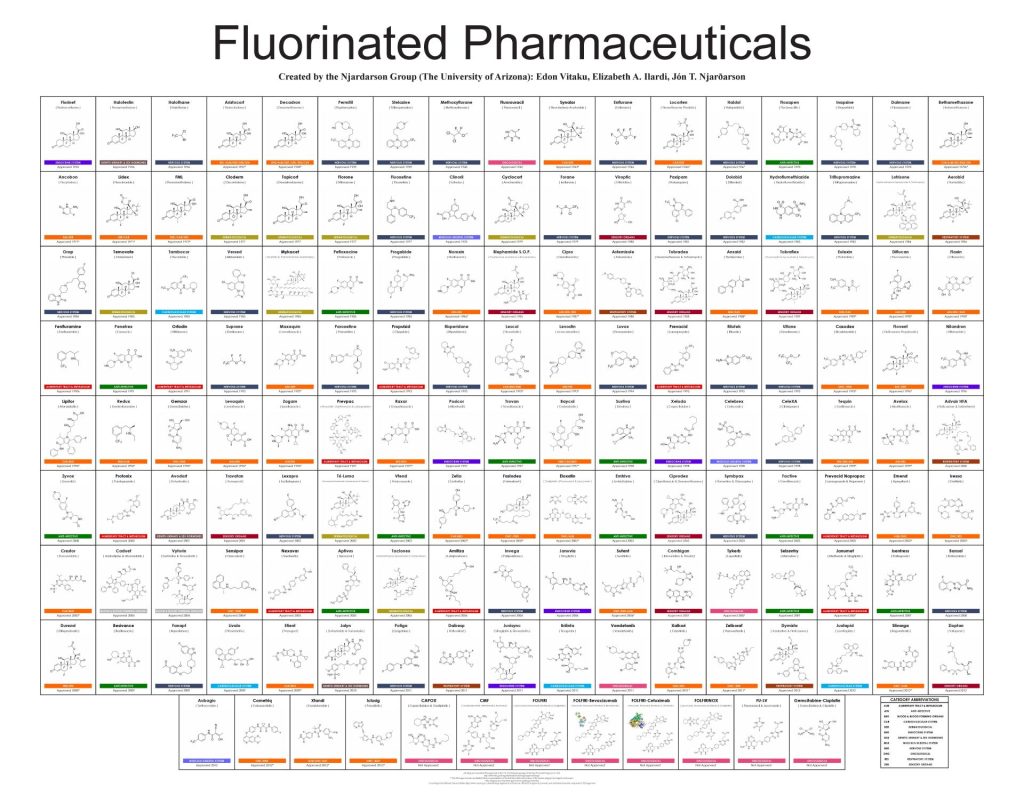
Pharmaceutical Analysis for Non-Experts (2014-Present): Following in the footsteps of the Njardarson group pharmaceutical posters the group set out to use this dataset to perform comprehensive analyses of various “privileged” chemical structural motifs and atoms found in pharmaceuticals for the benefit of non-experts and experts alike. These efforts have received most positive response from the community and the publications that detail the Njardarson group efforts in this arena are presented below.
(1) Ilardi, E. A.; Vitaku, E.; Njardarson, J. T. “Data Mining for Sulfur and Fluorine: An Evaluation of Pharmaceuticals to Reveal Opportunities for Drug Design and Discovery” J. Med. Chem. 2014, 57, 2832-2842.
(2) Vitaku, E.; Smith, D. T.; Njardarson, J. T. “Analysis of the Structural Diversity, Substitution Patterns and Frequency of Nitrogen Heterocycles among US FDA Approved Pharmaceuticals” J. Med. Chem. 2014, 57, 10257-10274.
(3) Smith, B. R.; Eastman, C. M.; Njardarson, J. T. “Beyond C, H, O and N! Analysis of the Elemental Composition of US FDA Approved Drug Architectures” J. Med. Chem. 2014, 57, 9764-9773.
(4) Scott, K. A.; Njardarson, J. T. “Analysis of US FDA-Approved Drugs Containing Sulfur Atoms” Topics in Current Chemistry – Sulfur Chemistry, 2018, 376, 1-34.
(5) DeLost, M. D.; Smith, D. T.; Anderson, B. J.; Njardarson, J. T. “From Oxiranes to Oligomers: Architectures of US FDA Approved Pharmaceuticals Containing Oxygen Heterocycles” J. Med. Chem. 2018, 61, 10996-11020.
(6) Das, P.; Delost, M. D.; Qureshi, M. H.; Smith, D. T.; Njardarson, J. T. “A Survey of the Structures of US FDA Approved Combination Drugs” J. Med. Chem. 2019, 62, 4265-4311.
(7) Scott, K. A.; Qureshi, M. H.; Cox, P.; Marshall, C. M.; Stuart, B. A. R.; Wilcox, M.; Njardarson, J. T. “A Structural Analysis of the FDA Green Book-Approved Veterinary Drugs and Select Roles in Human Medicine” J. Med. Chem. 2020, 63, 15449-15482.
(8) Scott, K. A.; Cox, P. B.; Njardarson, J. T. “Phenols and Pharmaceuticals. Analysis of a Recurring Motif” J. Med. Chem. 2022, 65, 7044-7072.
Teaching OChem to Blind and Visually Impaired Students (2022-Present): Following a recent incredibly rewarding experience teaching a blind student Organic Chemistry, Professor Njardarson Wrote detailed account of his experiences with recommendations for teachers taking on this exciting challenge to build upon. These is detailed in: Njardarson, J. T. “Introductory Organic Chemistry (First-Semester) for Blind and Visually Impaired Students: Practical Lessons and Experiences” J. Chem. Ed. 2023, 100, 3960-3967.